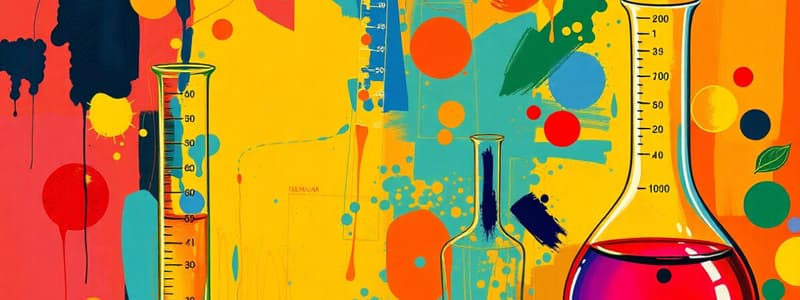Podcast
Questions and Answers
What defines a solution?
What defines a solution?
- A substance that can only exist in liquid form
- A mixture that cannot be separated by physical means
- A homogeneous mixture of two or more components (correct)
- A heterogeneous mixture of two or more components
Which term refers to the substance being dissolved in a solution?
Which term refers to the substance being dissolved in a solution?
- Solute Concentration
- Solute (correct)
- Mixture
- Solvent
Which of the following equations represents the calculation of molarity?
Which of the following equations represents the calculation of molarity?
- M = equivalents of solute / liters of solution
- M = moles of solute / liters of solution (correct)
- M = volume of solute / volume of solution
- M = mass of solute / mass of solution
What happens to the boiling point of a solvent when a solute is added?
What happens to the boiling point of a solvent when a solute is added?
What is Raoult's Law used to determine?
What is Raoult's Law used to determine?
Which property is considered a colligative property?
Which property is considered a colligative property?
Which of the following describes an ideal solution?
Which of the following describes an ideal solution?
How is molality defined?
How is molality defined?
Flashcards are hidden until you start studying
Study Notes
Solutions: Class 12 NCERT - Key Concepts
Definitions
- Solution: A homogeneous mixture of two or more components.
- Solvent: The component that dissolves the solute (usually present in larger quantity).
- Solute: The substance being dissolved (usually present in smaller quantity).
Types of Solutions
- Liquid Solutions: Solvent is liquid (e.g., saltwater).
- Solid Solutions: Solvent is solid (e.g., alloys).
- Gaseous Solutions: Solvent is gas (e.g., air).
Concentration of Solutions
- Mass percent: (mass of solute / mass of solution) × 100
- Volume percent: (volume of solute / volume of solution) × 100
- Molarity (M): moles of solute / liters of solution
- Molality (m): moles of solute / kg of solvent
- Normality (N): equivalents of solute / liters of solution
Preparing Solutions
- Calculating the amount of solute needed based on desired molarity, volume, and molar mass.
- Diluting concentrated solutions using the formula: M1V1 = M2V2.
Colligative Properties
- Properties that depend on the number of solute particles in a solution, not their identity.
- Vapor Pressure Lowering: Presence of solute decreases vapor pressure of solvent.
- Boiling Point Elevation: Boiling point of solvent increases when a solute is added.
- ΔTb = i × Kb × m
- Freezing Point Depression: Freezing point of solvent decreases when a solute is added.
- ΔTf = i × Kf × m
- Osmotic Pressure: Pressure required to prevent osmosis.
- π = iCRT (where C = molarity, R = ideal gas constant, T = absolute temperature).
Ideal and Non-Ideal Solutions
- Ideal Solutions: Follow Raoult's law; the solute-solvent interaction is similar to solute-solute and solvent-solvent interactions.
- Non-Ideal Solutions: Deviate from Raoult's law; interactions are different (positive or negative deviations).
Applications of Solutions
- Used in various fields such as chemistry, biology, medicine, and industry.
- Understanding solution properties is critical in processes like distillation, purification, and drug formulation.
Key Equations
- Raoult's Law: P_solution = X_solvent × P°_solvent
- molality (m): m = moles of solute / kg of solvent
Summary
- Solutions are fundamental in chemistry with diverse types and properties.
- Concentration calculations and understanding colligative properties are crucial for practical applications.
- The behavior of ideal vs. non-ideal solutions impacts various chemical processes.
Solutions: A Homogeneous Mixture
- Solutions are formed by mixing two or more components, resulting in a homogeneous mixture.
- The components are classified as the solvent (usually present in larger quantity) and the solute (usually present in smaller quantity).
- Solutions can exist in different states: liquid, solid, or gaseous, depending on the state of the solvent.
- Liquid solutions, like saltwater, have a liquid solvent.
- Solid solutions, like alloys, have a solid solvent.
- Gaseous solutions, like air, have a gas as the solvent.
Concentration: Quantifying the Amount of Solute
- The concentration of a solution describes the amount of solute present in a given amount of solvent or solution.
- Common ways to express concentration include:
- Mass percent: The ratio of the mass of solute to the mass of solution, multiplied by 100.
- Volume percent: The ratio of the volume of solute to the volume of solution, multiplied by 100.
- Molarity (M): Moles of solute per liter of solution.
- Molality (m): Moles of solute per kilogram of solvent.
- Normality (N): Equivalents of solute per liter of solution.
Preparing Solutions: Achieving Desired Concentrations
- Calculations are essential to determine the amount of solute needed to prepare a solution with a specific concentration.
- Diluting concentrated solutions can be done using the formula: M1V1 = M2V2, where M1 and V1 are the initial molarity and volume, and M2 and V2 are the final molarity and volume.
Colligative Properties: Properties Dependent on Solute Particles
- Colligative properties of a solution are those that depend on the number of solute particles present, not their identity.
- These properties are influenced by the presence of solute particles and include:
- Vapor Pressure Lowering: The presence of solute decreases the vapor pressure of the solvent.
- Boiling Point Elevation: The boiling point of the solvent increases when a solute is added. The change in boiling point (ΔTb) can be calculated using the formula: ΔTb = i × Kb × m, where i is the van't Hoff factor, Kb is the molal boiling point elevation constant, and m is the molality.
- Freezing Point Depression: The freezing point of the solvent decreases when a solute is added. The change in freezing point (ΔTf) can be calculated using the formula: ΔTf = i × Kf × m, where i is the van't Hoff factor, Kf is the molal freezing point depression constant, and m is the molality.
- Osmotic Pressure: The pressure required to prevent osmosis. Osmotic pressure (π) can be calculated using the formula: π = iCRT, where C is the molarity, R is the ideal gas constant, and T is the absolute temperature.
Ideal and Non-Ideal Solutions: Understanding Deviations
- Ideal Solutions: Solutions that follow Raoult's Law, meaning the solute-solvent interaction is similar to solute-solute and solvent-solvent interactions.
- Non-Ideal Solutions: Solutions that deviate from Raoult's Law, indicating that interactions between solute and solvent are different from interactions between solute and solute or solvent and solvent. These deviations can be positive or negative.
Applications of Solutions: A Wide Range of Uses
- Solutions play a crucial role in various fields like chemistry, biology, medicine, and industry.
- Understanding solution properties is vital for many processes, such as distillation, purification, and drug formulation.
Key Equations
- Raoult's Law: P_solution = X_solvent × P°_solvent, where P_solution is the vapor pressure of the solution, X_solvent is the mole fraction of the solvent, and P°_solvent is the vapor pressure of the pure solvent.
- Molality (m): m = moles of solute / kg of solvent.
Studying That Suits You
Use AI to generate personalized quizzes and flashcards to suit your learning preferences.



